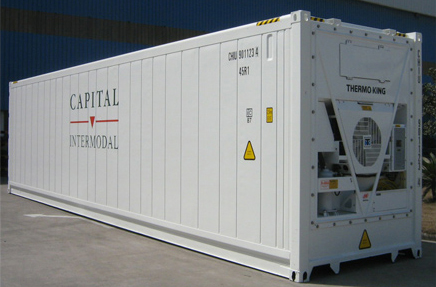
Fig :Reefer Container
Related articles
Reefer cargo Handling In PortReefer containers shall be plugged in and supplied with ships power as soon as practicable after loading. In case it is to be done by shore hands, ships crew shall still closely monitor the operation and confirm that all reefer containers are supplied with power earliest after loading....
Reefer cargo care at seaAt sea, all reefer containers shall be monitored by checking physically at least Twice daily (weather permitting). All monitored data for each reefer container on board shall be entered in a reefer monitoring log and retained for 3 years. Some reefer containers with special cargo (e.g.: VIP cargo) come with instructions for more frequent monitoring and reporting. Such instructions shall be strictly followed.
....
Commodities Shipped In Reefer ContainersSome cargoes may require controlled humidity (e.g. flower bulbs). It should be remembered in such cases that many refrigeration units are only capable of reducing humidity within the cargo space and the settings should be applied accordingly.
....
Reefer Cargo Temperature RecordingA Partlow recorder registers temperature on a pressure sensitive circular chart over 31 day period. If the voyage transit is expected to exceed 31 days, care must be taken to ensure charts are replaced before expiry. The first chart should be placed under-neath the new chart in order to build up a complete temperature record for the entire voyage up until arrival at the final destination.
.....
Reefer Cargo Maintaining RecordsMonitoring the digital & chart temperatures of all reefer containers at least twice a day. Daily reefer container temperature check lists should be maintained, and printouts from monitoring unit should be preserved.....
Reefer Cargo DefrostingDuring the operation of a refrigeration unit, a layer of ice will form on the evaporator coils depending on the temperature set, the temperature of the cargo, the amount of fresh air ventilation and the cargo humidity.
The unit periodically enters a phase where heat is produced by a series of electrical bars, allowing defrosting to take place. At such times, all fans are turned off automatically in order to prevent heat from entering the cargo compartment. ....
Basic check item prior stowing Reefer Cargo Stowage location of reefers must be checked against vessels reefer receptacle locations. In case reefer containers must be loaded in irregular locations, it must be confirmed that monitoring and repair will be possible during the voyage and that vessel has sufficient extension cables for providing power. ....
Container handling more info pages:
-
Containership advantages
-
Containership cargo stowage and planning
-
Procedures and guidelines for dangerous cargo handling
-
How to avoid irregular stowage of containers ?
-
Measures against lashing failure
-
Reefer container stowage guideline
-
Care of Reefer container during sea passage
-
Container ships procedures for securing for sea
-
Deployment and monitoring of moorings and safety of crew
-
Cargo securing procedure for container ship
Confirmation and record of securing
The following checklists shall be used to confirm the securing condition:
Cargo ships preparation for sailing
Checklist for Navigation in Heavy weather
Checklist for Departure How to maintain Water tightness, Seaworthiness, Fire integrity and Security of ship ?
Securing your vessel for sea passage - when to check and what to check
Confirming stability & hull strength prior sailing
Collecting Information and Data for Passage Planning
 Other info pages !
Ships Charterparties
Other info pages !
Ships Charterparties Related terms & guideline
Stevedores injury How to prevent injury onboard
Environmental issues How to prevent marine pollution
Cargo & Ballast Handling Safety Guideline
Reefer cargo handling Troubleshoot and countermeasures
DG cargo handling Procedures & Guidelines
Safety in engine room Standard procedures
Questions from user and feedback Read our knowledgebase
Home page
 ShipsBusiness.com is merely an informational site about various aspects of ships operation,maintenance procedure,
prevention of pollution and many safety guideline. The procedures explained here are only indicative,
not exhaustive in nature and one must always be guided by practices of good seamanship.
ShipsBusiness.com is merely an informational site about various aspects of ships operation,maintenance procedure,
prevention of pollution and many safety guideline. The procedures explained here are only indicative,
not exhaustive in nature and one must always be guided by practices of good seamanship.
User feedback is
important to update our database. For any comment or suggestions please Contact us
Site Use and Privacy - Read our privacy policy and site use information.
//Home //Terms and conditions of use
Copyright © 2015 www.shipsbusiness.com All rights reserved.


